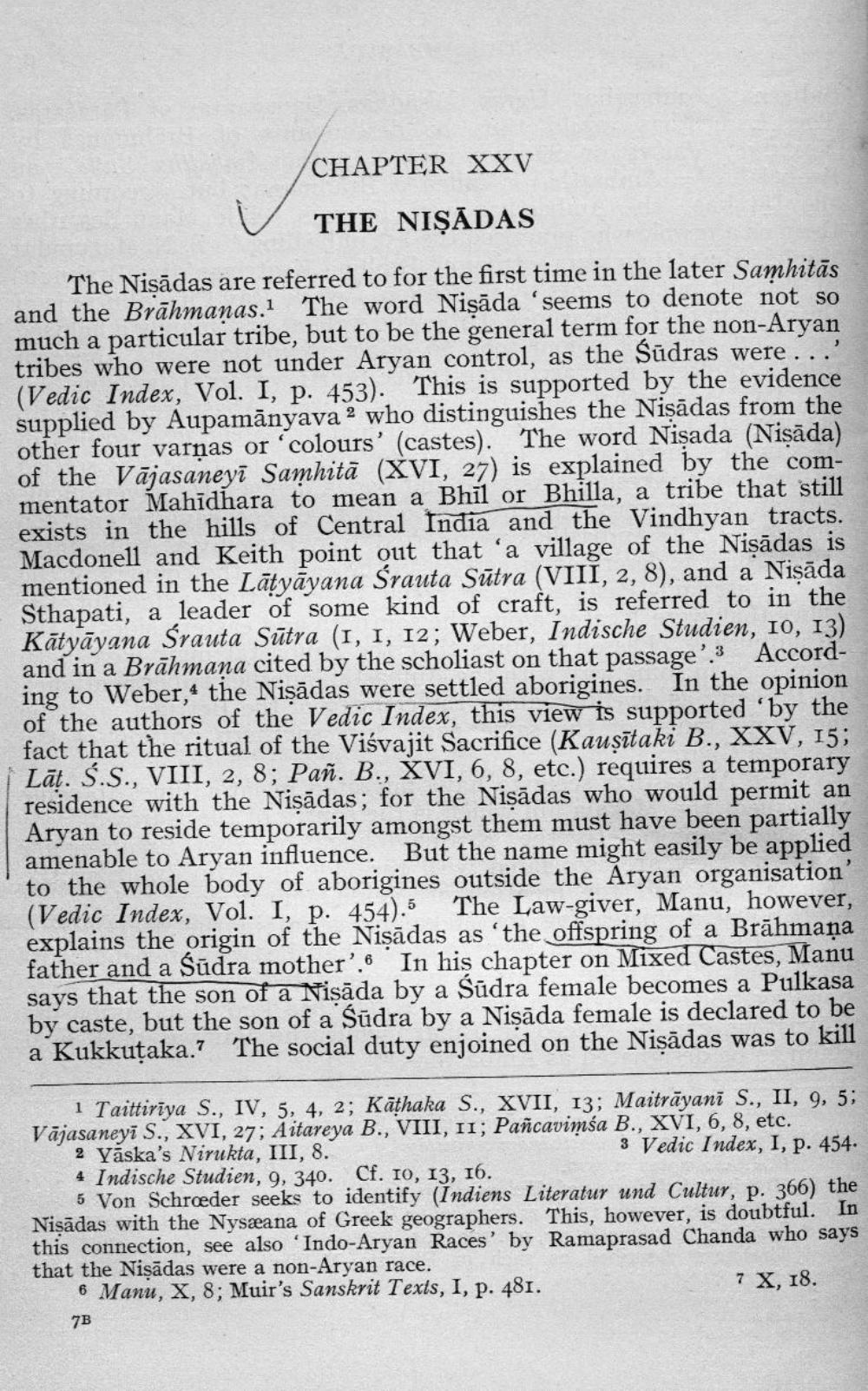________________
CHAPTER XXV THE NIŞĀDAS
The Nisādas are referred to for the first time in the later Samhitās and the Brāhmanas. The word Nişāda 'seems to denote not so much a particular tribe, but to be the general term for the non-Aryan tribes who were not under Aryan control, as the Sūdras were...' (Vedic Index, Vol. I, p. 453). This is supported by the evidence supplied by Aupamānyava 2 who distinguishes the Nisādas from the other four varņas or colours' (castes). The word Nişada (Nişāda) of the Vājasaneyī Samhitā (XVI, 27) is explained by the commentator Mahīdhara to mean a Bhil or Bhilla, a tribe that still exists in the hills of Central India and the Vindhyan tracts. Macdonell and Keith point out that 'a village of the Nişādas is mentioned in the Latyāyana Śrauta Sūtra (VIII, 2, 8), and a Nisāda Sthapati, a leader of some kind of craft, is referred to in the Kātyāyana Srauta Sūtra (I, I, 12; Weber, Indische Studien, 10, 13) and in a Brāhmana cited by the scholiast on that passage'.3 According to Weber,4 the Nişādas were settled aborigines. In the opinion of the authors of the Vedic Index, this view is supported ‘by the
fact that the ritual of the Viśvajit Sacrifice (Kausītaki B., XXV, 15; | Lāt. S.S., VIII, 2, 8; Pañ. B., XVI, 6, 8, etc.) requires a temporary residence with the Nişādas; for the Nişādas who would permit an Aryan to reside temporarily amongst them must have been partially amenable to Aryan influence. But the name might easily be applied to the whole body of aborigines outside the Aryan organisation' (Vedic Index, Vol. I, p. 454),5 The Law-giver, Manu, however, explains the origin of the Nişādas as 'the offspring of a Brāhmaṇa father and a Sūdra mother'. In his chapter on Mixed Castes, Manu says that the son of a Nisāda by a Sūdra female becomes a Pulkasa by caste, but the son of a Sūdra by a Nisāda female is declared to be a Kukkuțaka.? The social duty enjoined on the Nişādas was to kill
1 Taittirīya S., IV, 5, 4, 2; Kāthaka S., XVII, 13; Maitrāyani S., II, 9, 5; Vājasaneyi S., XVI, 27; Aitareya B., VIII, II; Pañcavimśa B., XVI, 6, 8, etc. 2 Yaska's Nirukta, III, 8.
3 Vedic Index, I, p. 454. 4 Indische Studien, 9, 340. Cf. 10, 13, 16.
5 Von Schroeder seeks to identify (Indiens Literatur und Cultur, p. 366) the Nisādas with the Nysæana of Greek geographers. This, however, is doubtful. In this connection, see also 'Indo-Aryan Races' by Ramaprasad Chanda who says that the Nisādas were a non-Aryan race. 6 Manu, X, 8; Muir's Sanskrit Texts, I, p. 481.
7 X, 18. 7B




